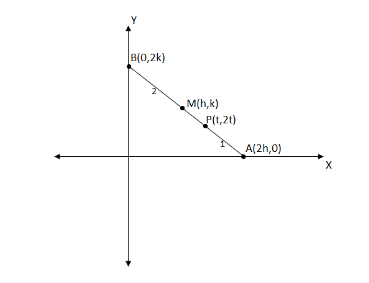Answer
397.2k+ views
Hint: We know the section formula, the coordinates of the point P(x, y) which divides the line segment joining the points \[A({x_1},{y_1})\] and \[B({x_2},{y_2})\] internally, in the ratio \[{m_1}:{m_2}\] are \[\left( {\dfrac{{{m_1}{x_2} + {m_2}{x_1}}}{{{m_1} + {m_2}}},\dfrac{{{m_1}{y_2} + {m_2}{y_1}}}{{{m_1} + {m_2}}}} \right)\] . We choose the midpoint as \[M(h,k)\] and using the above formula we find the coordinate values ‘h’ and ‘k’ to obtain the required result.
Complete step-by-step answer:
Let \[M(h,k)\] be the midpoint of line AB. Given A, B move on the ‘x’ and ‘y’ axis respectively. Then it is obvious that the coordinates of A and B are \[A(2h,0)\] and \[B(0,2k)\] .
Since point \[P(t,2t)\] is first trisection it divides A and B into \[1:2\] ratio. See in the below diagram for understanding point of view.

We have \[A({x_1},{y_1}) = A(2h,0)\] , \[B({x_2},{y_2}) = B(0,2k)\] and which divides in the ratio \[1:2\] . Using the section formula we find the coordinates of the point P.
Using the formula \[\left( {\dfrac{{{m_1}{x_2} + {m_2}{x_1}}}{{{m_1} + {m_2}}},\dfrac{{{m_1}{y_2} + {m_2}{y_1}}}{{{m_1} + {m_2}}}} \right)\]
\[ \Rightarrow = P\left( {\dfrac{{\left( {1 \times 0} \right) + \left( {2 \times 2h} \right)}}{{1 + 2}},\dfrac{{\left( {1 \times 2k} \right) + \left( {2 \times 0} \right)}}{{1 + 2}}} \right)\]
\[ \Rightarrow = P\left( {\dfrac{{0 + 4h}}{3},\dfrac{{2k + 0}}{3}} \right)\]
\[ \Rightarrow = P\left( {\dfrac{{4h}}{3},\dfrac{{2k}}{3}} \right)\]
But we already have point p coordinates as \[P(t,2t)\] .
Comparing ‘x’ and ‘y’ coordinates in both Points P we have
The ‘x’ coordinate \[\dfrac{{4h}}{3} = t\]
Multiply by 3 on both sides.
\[ \Rightarrow 4h = 3t{\text{ - - - - - - - (1)}}\]
The ‘y’ coordinate \[\dfrac{{2k}}{3} = 2t\]
Cancelling 2 on both sides,
\[ \Rightarrow \dfrac{k}{3} = t\]
Multiply by 3 on both sides,
\[ \Rightarrow k = 3t{\text{ - - - - - - - (2)}}\]
Now substituting equation (2) in equation (1) we have \[ \Rightarrow 4h = k\] .
But we have options in ‘x’ and ‘y’ variables, so we have
\[ \Rightarrow 4x = y\] (Because \[(h,y) = (x,y)\] )
So, the correct answer is “Option C”.
Note: In general Trisection is the division of a quantity or figure into three equal parts. In the above problem when P is the first trisection there is another two trisection. Hence we take the ratio as \[1:2\] . Remember the formula of section formula. Careful in the substitution and calculation part.
Complete step-by-step answer:
Let \[M(h,k)\] be the midpoint of line AB. Given A, B move on the ‘x’ and ‘y’ axis respectively. Then it is obvious that the coordinates of A and B are \[A(2h,0)\] and \[B(0,2k)\] .
Since point \[P(t,2t)\] is first trisection it divides A and B into \[1:2\] ratio. See in the below diagram for understanding point of view.

We have \[A({x_1},{y_1}) = A(2h,0)\] , \[B({x_2},{y_2}) = B(0,2k)\] and which divides in the ratio \[1:2\] . Using the section formula we find the coordinates of the point P.
Using the formula \[\left( {\dfrac{{{m_1}{x_2} + {m_2}{x_1}}}{{{m_1} + {m_2}}},\dfrac{{{m_1}{y_2} + {m_2}{y_1}}}{{{m_1} + {m_2}}}} \right)\]
\[ \Rightarrow = P\left( {\dfrac{{\left( {1 \times 0} \right) + \left( {2 \times 2h} \right)}}{{1 + 2}},\dfrac{{\left( {1 \times 2k} \right) + \left( {2 \times 0} \right)}}{{1 + 2}}} \right)\]
\[ \Rightarrow = P\left( {\dfrac{{0 + 4h}}{3},\dfrac{{2k + 0}}{3}} \right)\]
\[ \Rightarrow = P\left( {\dfrac{{4h}}{3},\dfrac{{2k}}{3}} \right)\]
But we already have point p coordinates as \[P(t,2t)\] .
Comparing ‘x’ and ‘y’ coordinates in both Points P we have
The ‘x’ coordinate \[\dfrac{{4h}}{3} = t\]
Multiply by 3 on both sides.
\[ \Rightarrow 4h = 3t{\text{ - - - - - - - (1)}}\]
The ‘y’ coordinate \[\dfrac{{2k}}{3} = 2t\]
Cancelling 2 on both sides,
\[ \Rightarrow \dfrac{k}{3} = t\]
Multiply by 3 on both sides,
\[ \Rightarrow k = 3t{\text{ - - - - - - - (2)}}\]
Now substituting equation (2) in equation (1) we have \[ \Rightarrow 4h = k\] .
But we have options in ‘x’ and ‘y’ variables, so we have
\[ \Rightarrow 4x = y\] (Because \[(h,y) = (x,y)\] )
So, the correct answer is “Option C”.
Note: In general Trisection is the division of a quantity or figure into three equal parts. In the above problem when P is the first trisection there is another two trisection. Hence we take the ratio as \[1:2\] . Remember the formula of section formula. Careful in the substitution and calculation part.
Recently Updated Pages
How many sigma and pi bonds are present in HCequiv class 11 chemistry CBSE

Why Are Noble Gases NonReactive class 11 chemistry CBSE

Let X and Y be the sets of all positive divisors of class 11 maths CBSE

Let x and y be 2 real numbers which satisfy the equations class 11 maths CBSE

Let x 4log 2sqrt 9k 1 + 7 and y dfrac132log 2sqrt5 class 11 maths CBSE

Let x22ax+b20 and x22bx+a20 be two equations Then the class 11 maths CBSE

Trending doubts
Fill the blanks with the suitable prepositions 1 The class 9 english CBSE

At which age domestication of animals started A Neolithic class 11 social science CBSE

Which are the Top 10 Largest Countries of the World?

Give 10 examples for herbs , shrubs , climbers , creepers

Difference between Prokaryotic cell and Eukaryotic class 11 biology CBSE

Difference Between Plant Cell and Animal Cell

Write a letter to the principal requesting him to grant class 10 english CBSE

Change the following sentences into negative and interrogative class 10 english CBSE

Fill in the blanks A 1 lakh ten thousand B 1 million class 9 maths CBSE



